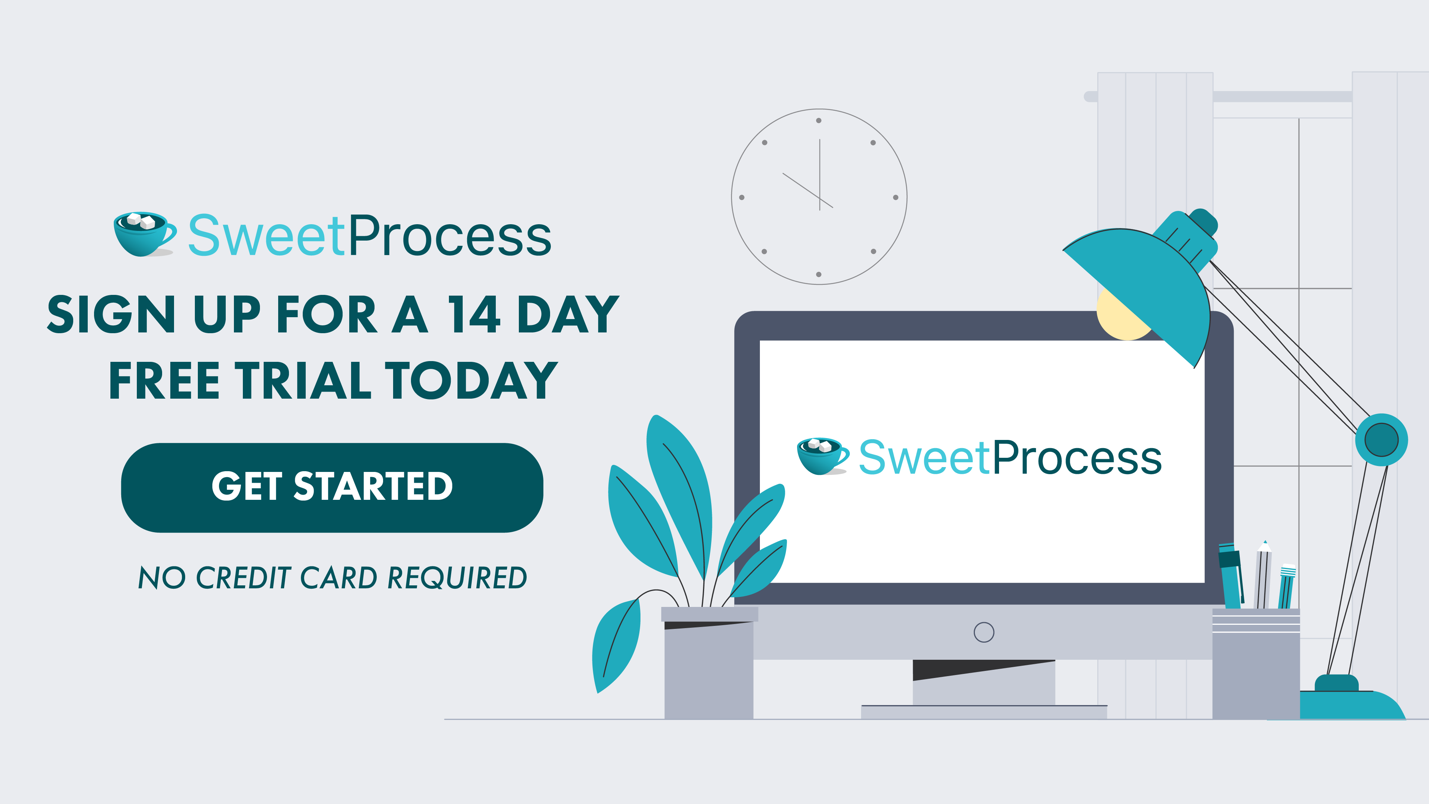Last Updated on April 14, 2025 by Owen McGab Enaohwo

You just launched a new product. The excitement is high since you’ve poured months into development, perfecting the design. You’re confident customers will love it, but soon after launch, your inbox fills up with support tickets, all asking the same frustrating question: “How do I use this?”
Customers are confused, your support team is overwhelmed, and what should have been a smooth rollout turns into a time-consuming headache.
The culprit? A lack of clear, accessible instructions. Without a structured and detailed instruction manual template, even the most well-designed product can leave users feeling lost. Frustrated customers may give up entirely, leading to negative reviews, increased returns, and missed opportunities to build brand loyalty. Your business shouldn’t have to suffer because of missing or unclear documentation.
But the good news is that you don’t have to create an instruction manual from scratch. A well-designed manual can help your customers get the most out of your product by documenting everything they need to know about how to use it.
To save you time and effort, we’ve compiled some free detailed instruction templates you can customize to fit your business needs. These templates ensure that your instructions are clear, professional, and easy to follow without requiring hours of extra work.
With SweetProcess, you can create clear, professional instruction manuals that eliminate confusion and save your team time. Sign up for a 14-day free trial today and make your product or process effortless to follow!
Table of Contents
11 Free Instruction Manual Templates for Your Business Needs
How To Manage Your Instruction Manuals With SweetProcess
8 Things To Include When Creating Instruction Manuals
6 Benefits of Creating Instruction Manuals For Your Business
Streamline Your Instruction Manuals With SweetProcess
11 Free Instruction Manual Templates for Your Business Needs

Clear instruction manuals are essential for your customers and employees. As you develop this comprehensive resource, you need to provide detailed product info and descriptions to benefit them. However, there are instruction manuals for different industries.
We’ll explore 11 instruction manual templates, each designed for a specific purpose to help you get started.
1) Software User Manual Template
A software user manual serves as a comprehensive user guide on installing, navigating, and troubleshooting a software application independently. It provides step-by-step instructions, screenshots, and troubleshooting tips to ensure a smooth user experience. Without a proper manual, users may struggle to understand the software, leading to churn rates and an increased burden on customer support teams.
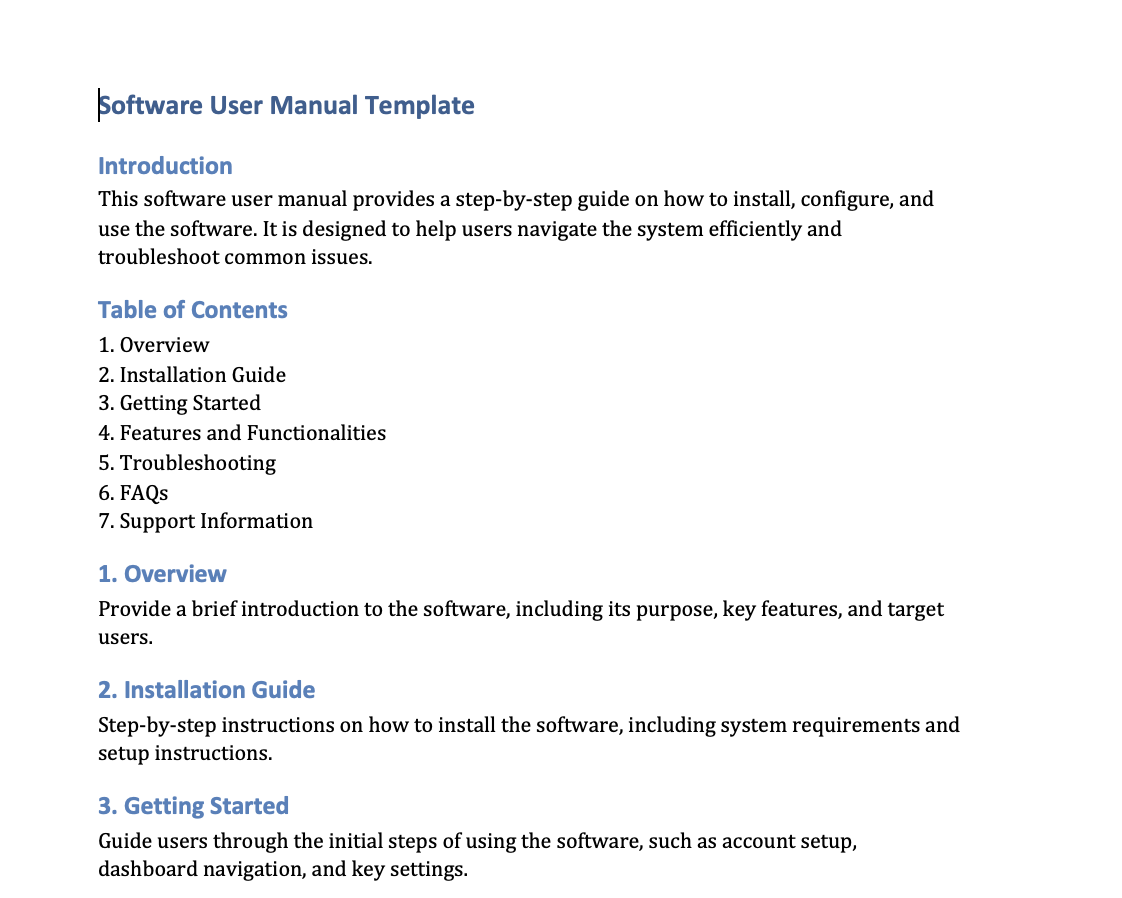
Download the Software User Manual Template
2) Standard Operating Procedures (SOP) Manual Template
Most business operations are guided by SOPs. This manual documents the exact steps you need to take to complete your routine processes. When the tasks are carried out correctly, you can minimize errors and keep all your operations consistent.
You can use this template to standardize your SOPs, especially if your organization has repetitive processes.
This will help you comply with industry regulations and ensure your employees are on the same page even when you make new hires.
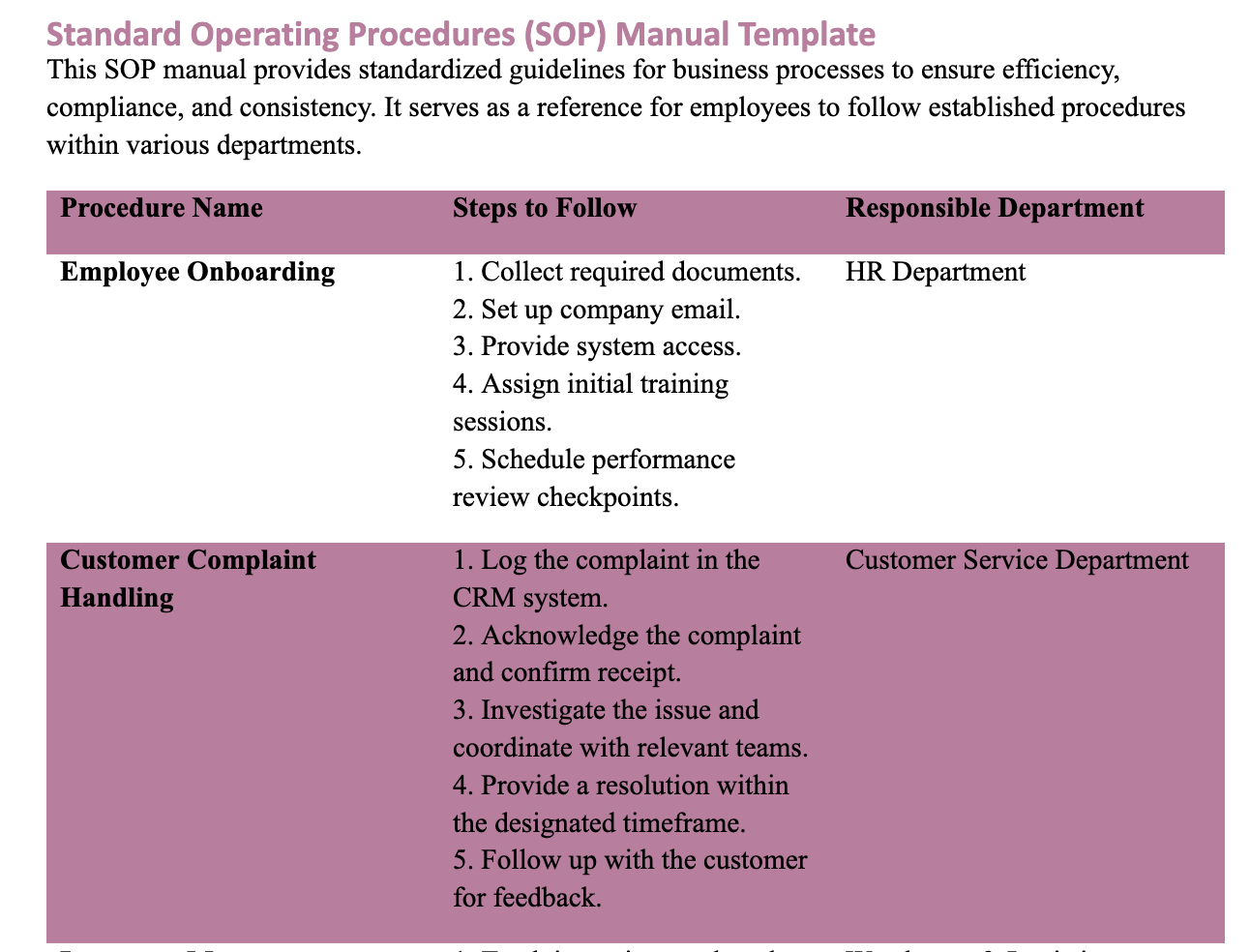
Download the SOP Manual Template
3) Operations Manual Template
Organizations rely on an operations manual to outline business policies, procedures, and daily workflows. It acts as a reference guide for employees, managers, and stakeholders to understand how different functions within a business should be carried out.
As part of the internal documentation, this manual provides a structured way to scale and ensure consistency across departments. With a template, you can design it much faster and customize it for different departments.
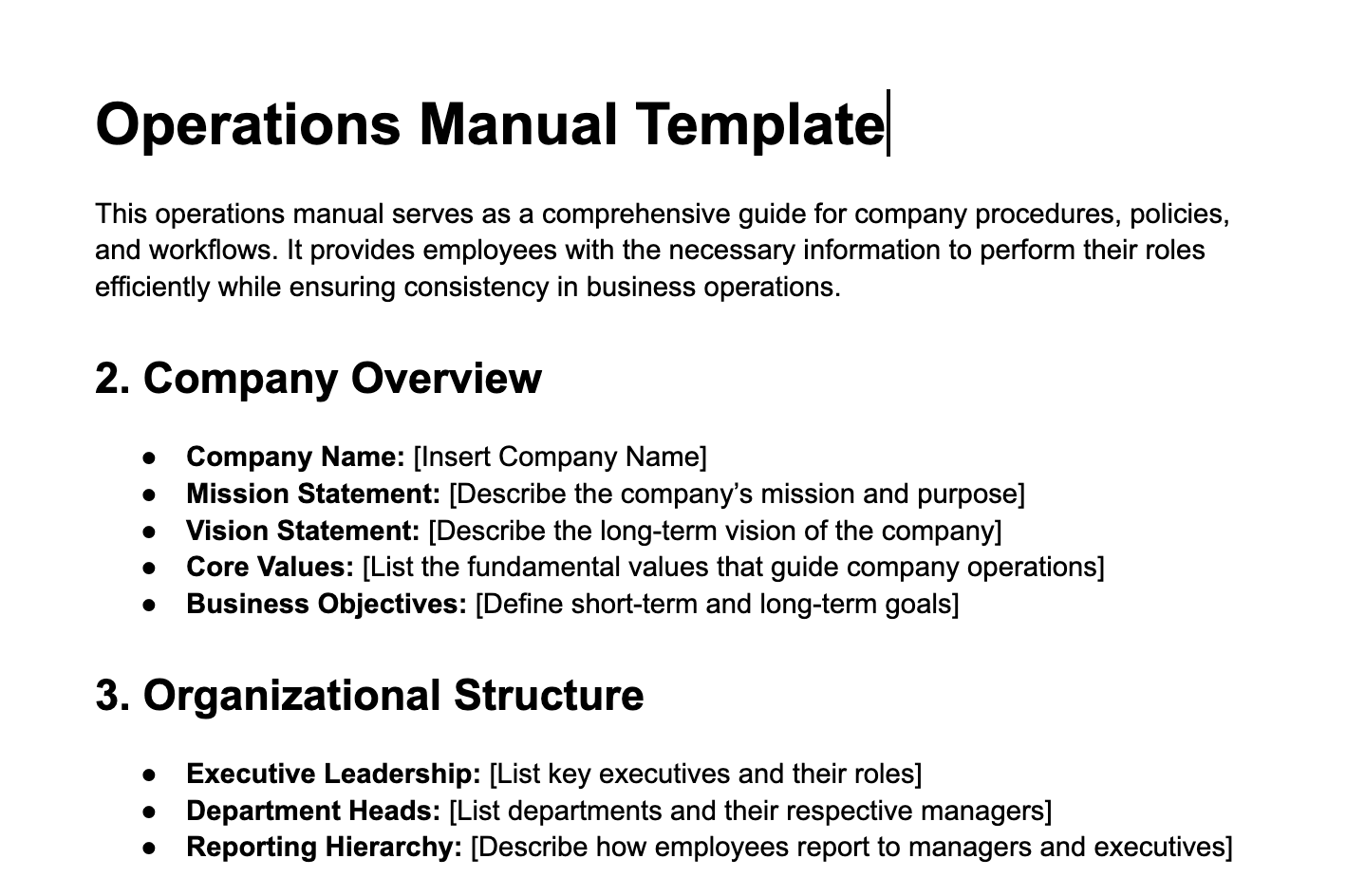
Download the Operations Manual Template
4) User Manual Template
If your company deals with consumer products, tech gadgets, or digital services, you must document the setup instructions and usage guidelines. For instance, if a customer signs up for your software or buys electronics or home appliances, you should send a personal user manual as part of the onboarding process.
A well-crafted user manual template includes key details and sections about how to use the product to enhance customer experience and reduce product misuse.
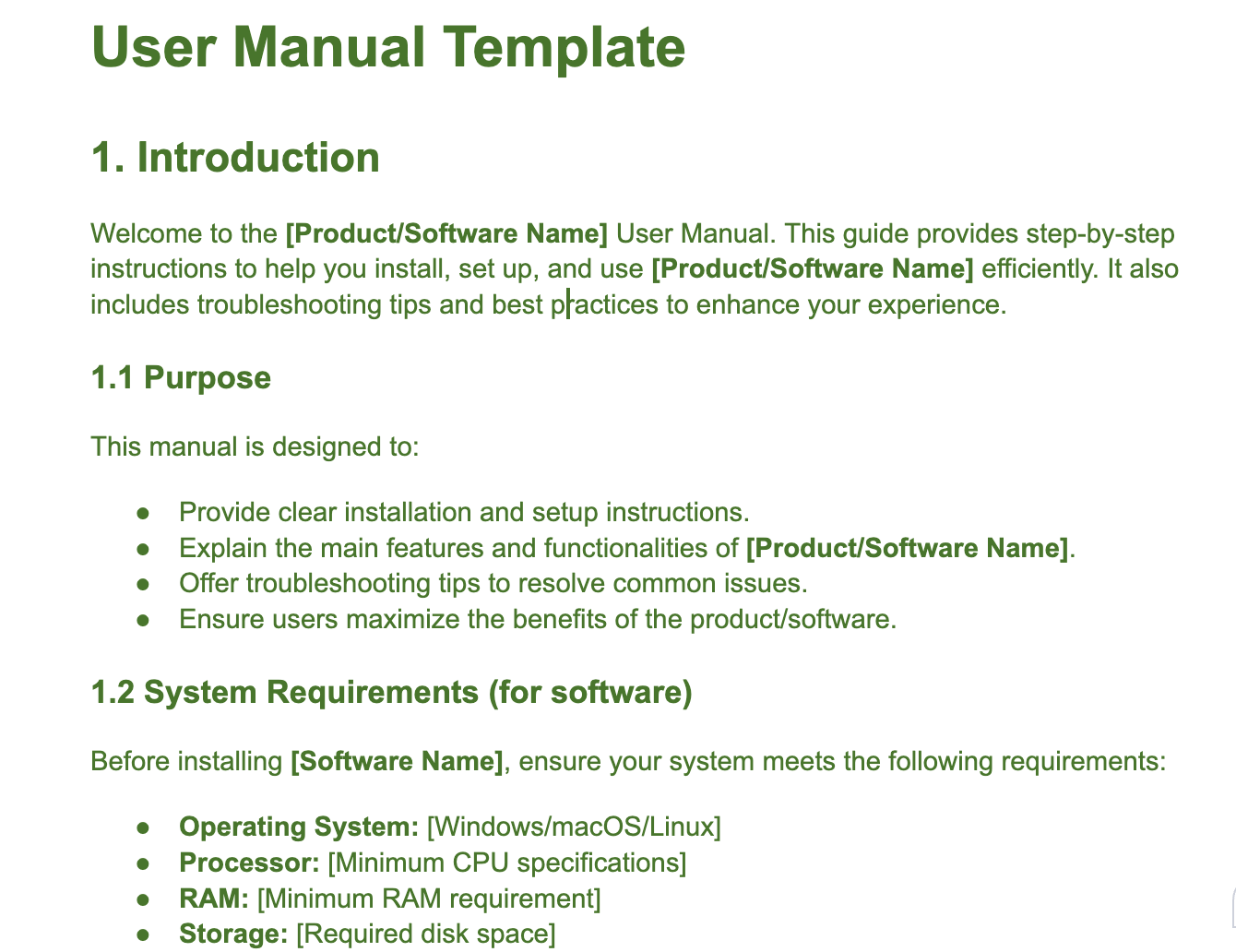
Download the User Manual Template
5) Training Manual Template
One of the ways to build a skilled workforce is by investing in training and development programs. A training manual helps you onboard new hires more seamlessly by outlining the company policies, job expectations, and any other personal information about their roles. Apart from newbies, they’re also essential for training seasoned employees.
These manuals are commonly used by HR teams, corporate trainers, and small business owners to ensure consistency in training programs. You can standardize training programs and save time with a proper training manual template.
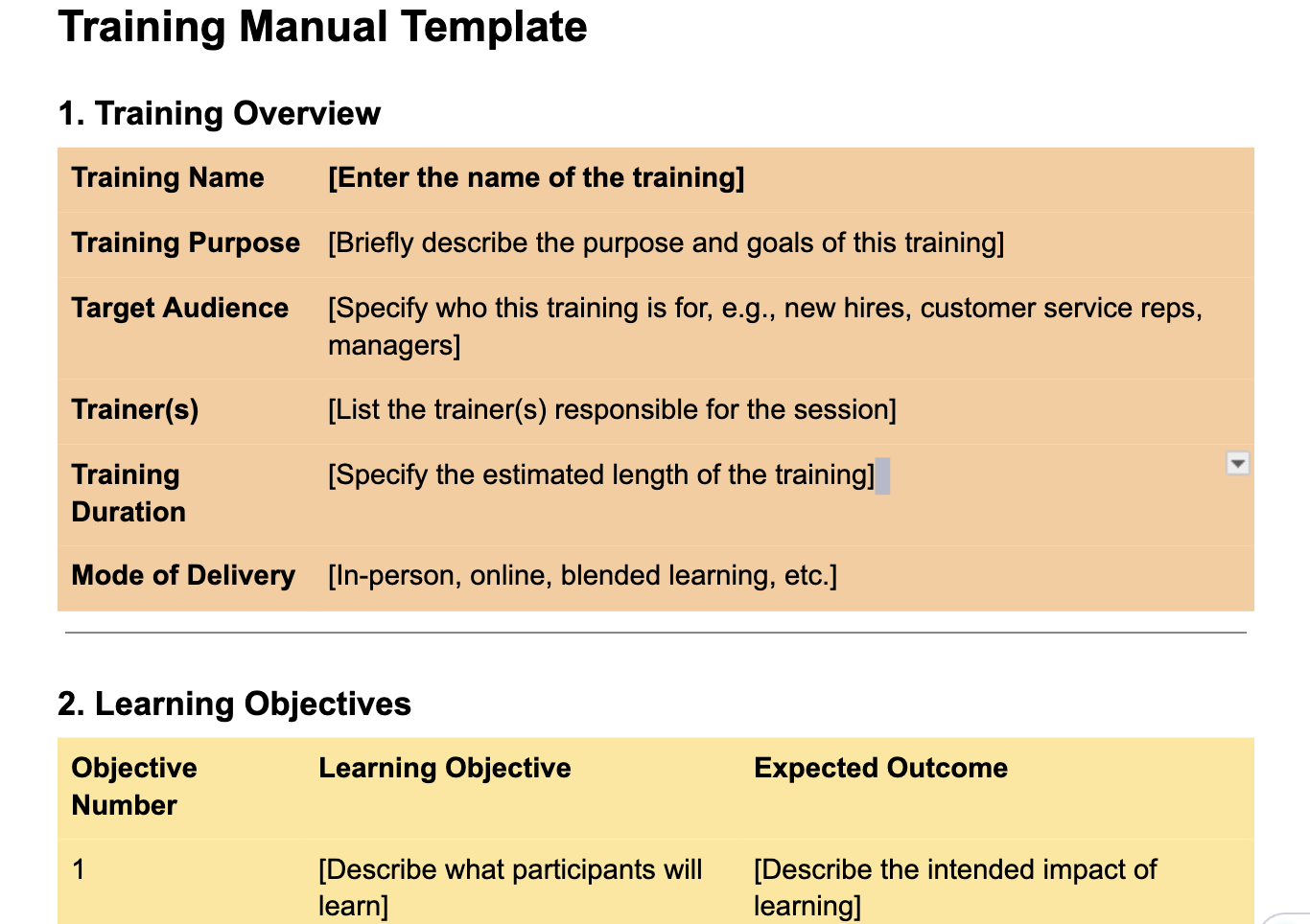
Download the Training Manual Template
6) Leadership Development Plan Template
A leadership development plan template comes in handy if you promote internally or plan to hire new managers. This document can structure a training approach to nurture employees into leadership roles. For instance, you can set leadership goals and create skill-building exercises that will help identify potential candidates.
HR managers and business owners can use this template to standardize leadership training and succession planning.
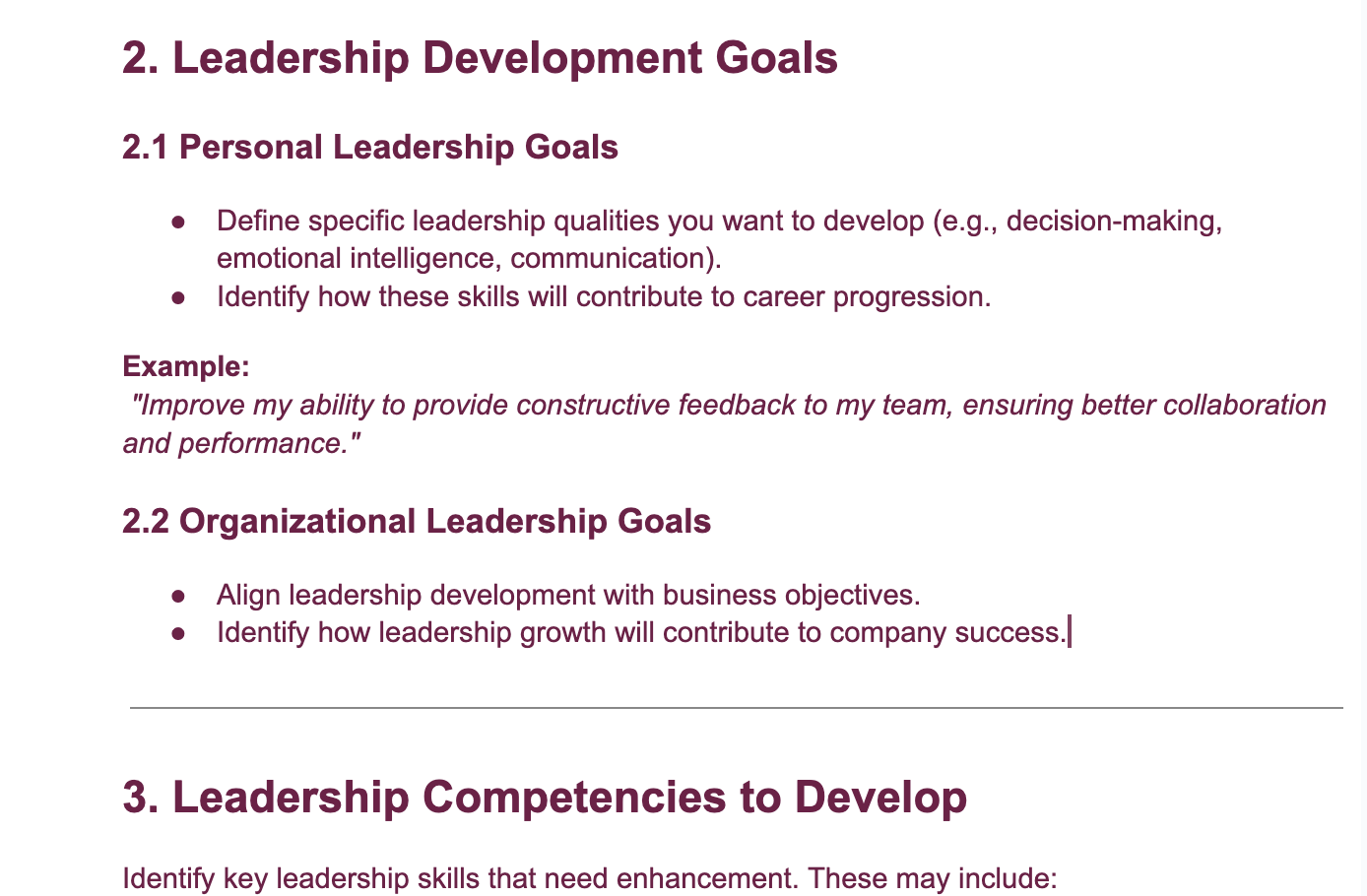
Download the Leadership Development Plan Template
7) Sales Training Guide Template
Your sales team needs a structure to equip them with skills and strategies for closing deals successfully. This user guide can help new sales reps or train experienced professionals on customer psychology, objection handling, and closing techniques.
A well-defined template ensures that sales teams follow a consistent approach when pitching and prospecting. It can also include tips on engaging customers, addressing their pain points, and responding to queries. Additionally, you can use this tool to improve product knowledge by including key details about your products and services.
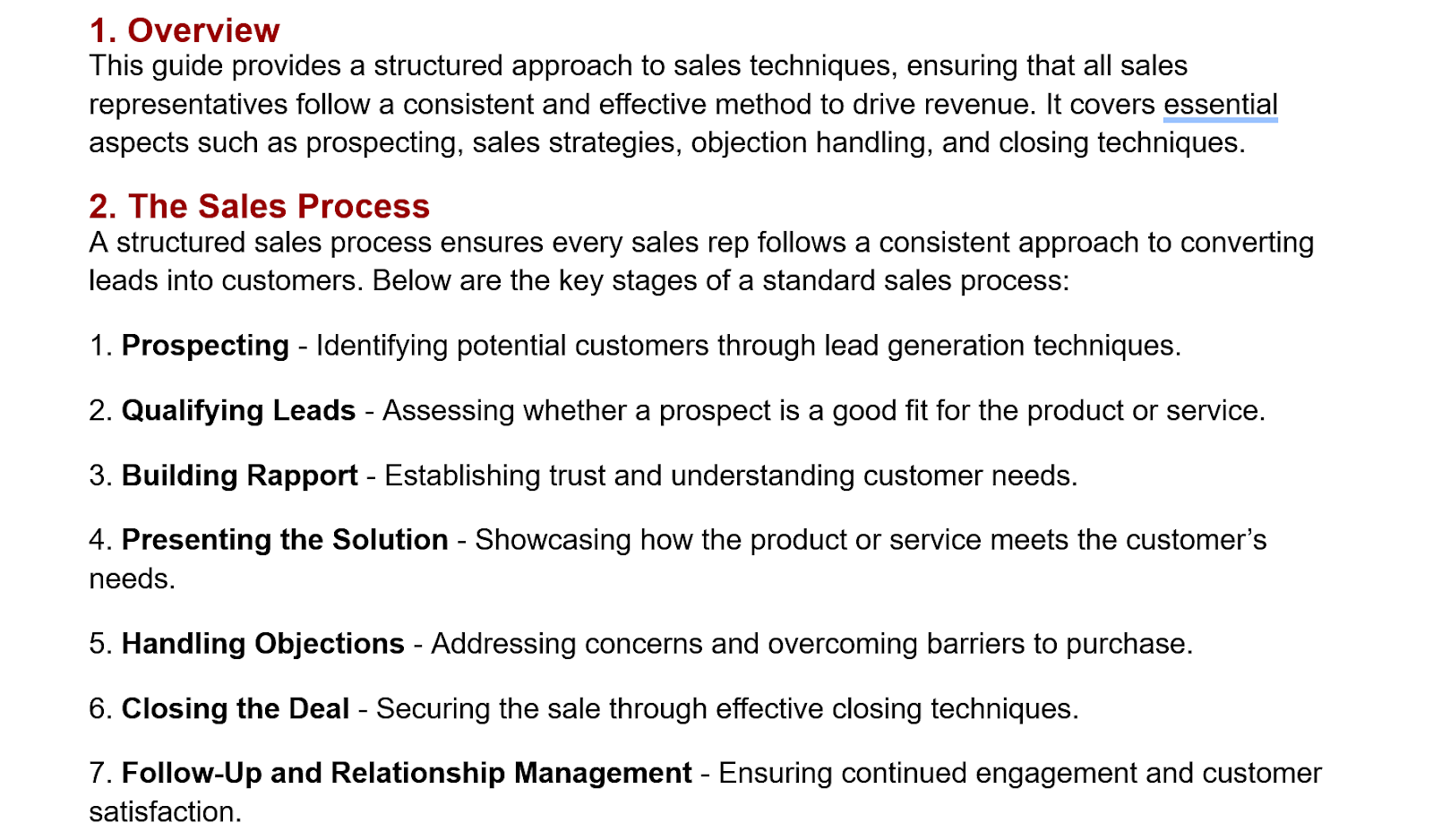
Download the Sales Training Guide Template
8) Customer Service Training Manual Template
Your customers depend on the support team for guidance when they feel stuck. Therefore, your service teams must have the right skills and knowledge to execute their roles. A customer service training manual documents all this information to ensure consistency in handling customer interactions, resolving issues, and maintaining a positive brand reputation.
For instance, if your clients need assistance setting up a new business tool, the entire team can communicate the same information. It’s also a great training tool for improving service quality and efficiency. When you have a documented manual, you can also reduce the training time and make onboarding much faster.
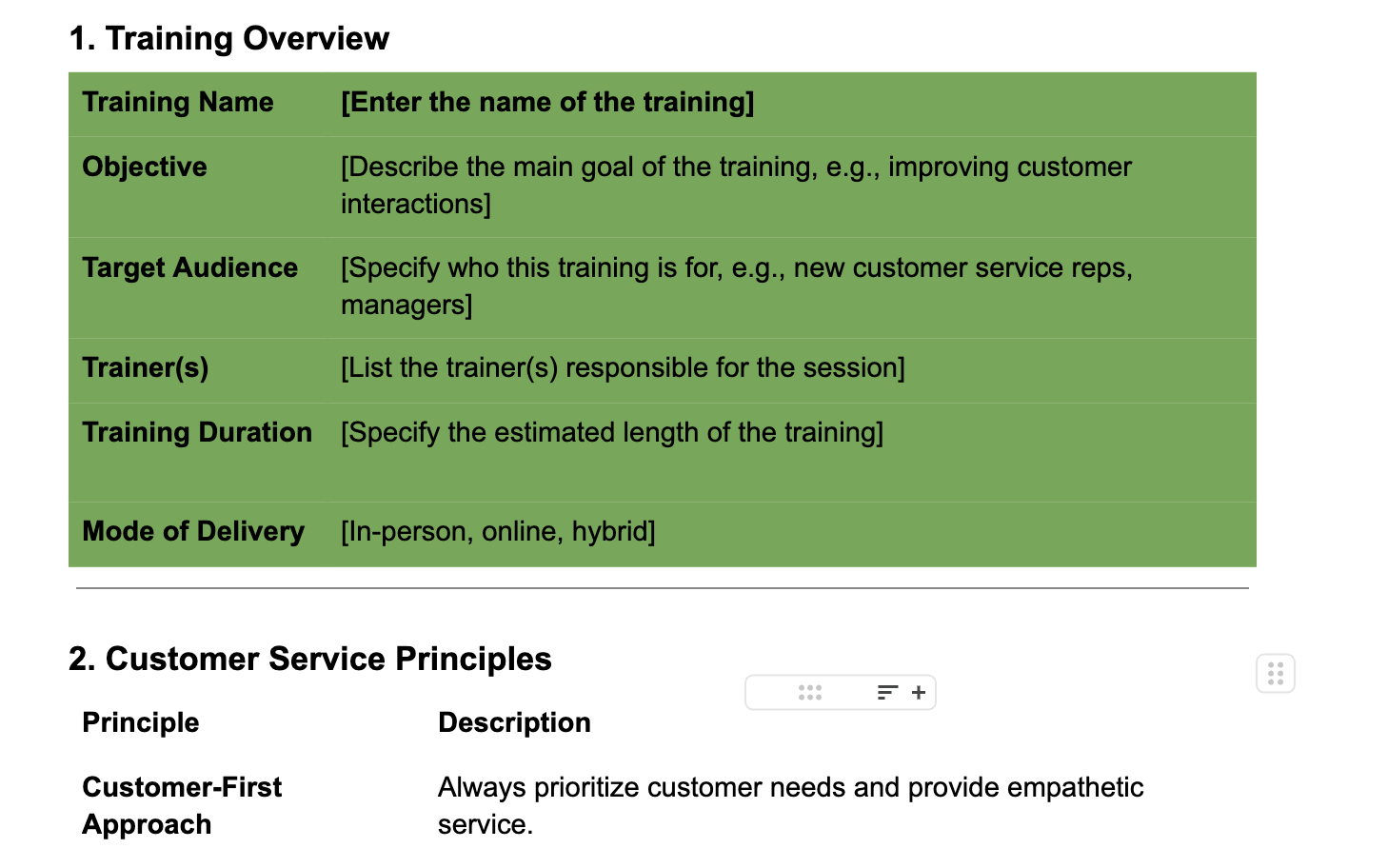
Download the Customer Service Training Manual Template
9) Product Training Template
Imagine how confusing it is if you just launched multiple products at the same time. Your sales and customer support teams have to understand how these products work to close deals and assist customers. Creating a product training template is the best way to support them in effectively communicating the product default value and troubleshooting common issues.
This document can include the product specifications, benefits, and differentiators. It will also empower the team to handle customer inquiries with confidence.
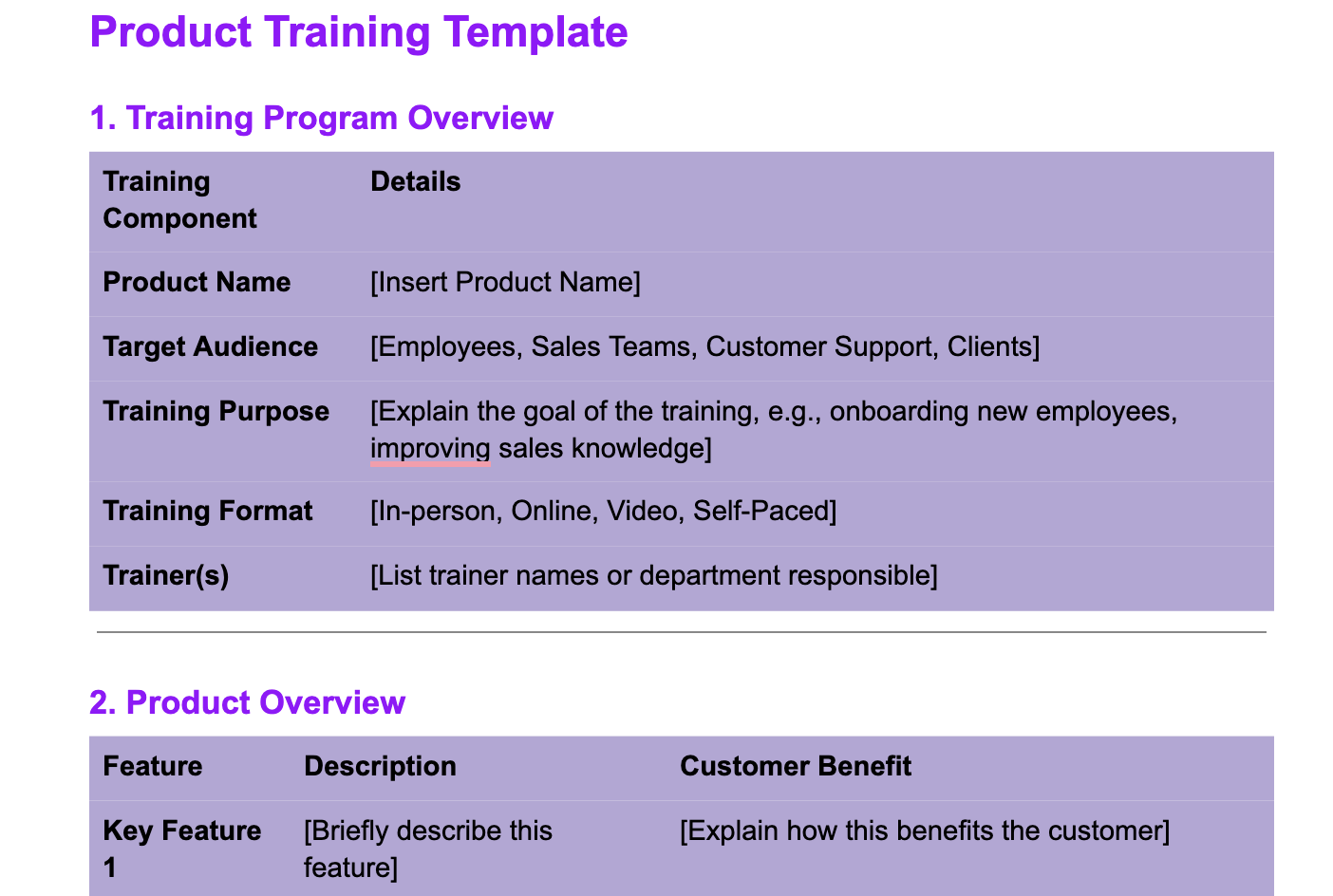
Download the Product Training Template
10) Employee Handbook Manual Template
Both new and seasoned employees require proper training. With an employee handbook manual template, you can develop a guide that will help you outline key company policies, workplace expectations, and employee rights and responsibilities. Once you hire new team members, you can share this handbook with them to onboard them much faster.
Additionally, this manual template serves as a reference guide for employees who need to know more about HR policies. This minimizes misunderstandings and ensures compliance with company and legal standards.
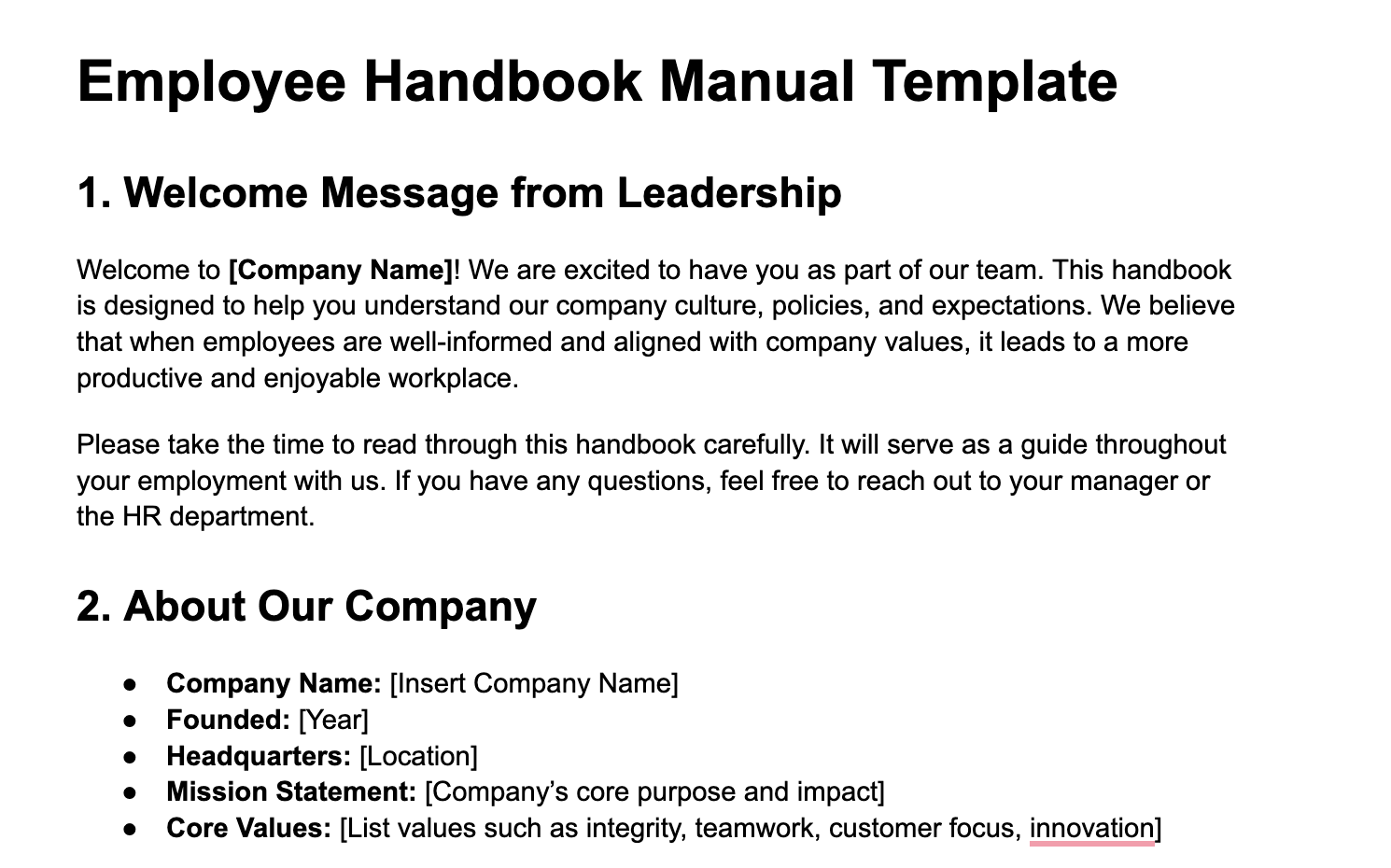
Download the Employee Handbook Manual Template
11) Work Instructions Manual Template
A work instructions manual template provides employees with step-by-step guidance on performing specific tasks or processes within a company.
Unlike general SOPs, work instructions primarily focus on completing a task efficiently, reducing errors, and ensuring consistency.
They can be used in sectors like manufacturing, customer service, or IT to enhance productivity and minimize confusion. Implementing this in your operations minimizes errors because every team member knows which processes to follow.
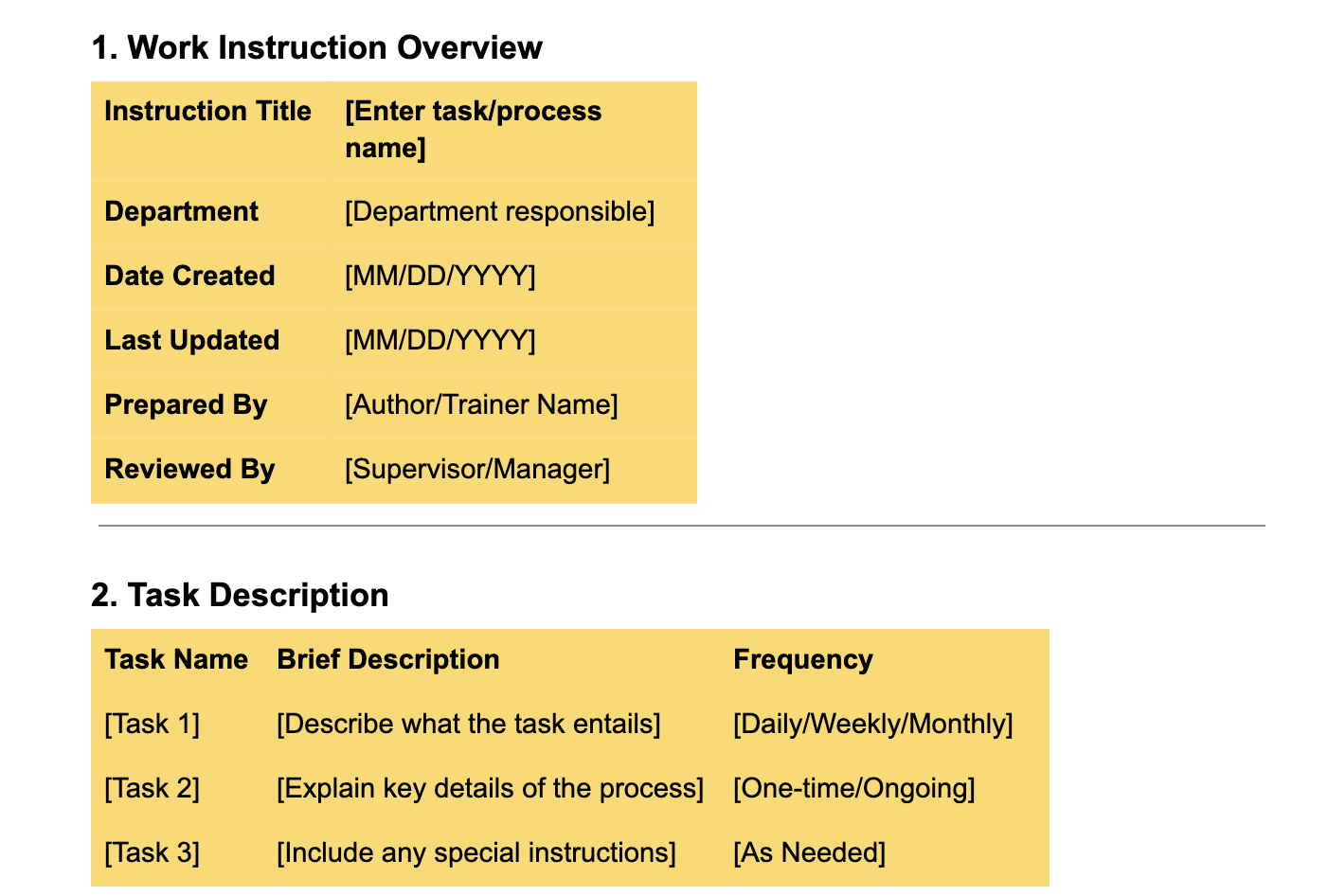
Download the Work Instructions Manual Template
How To Manage Your Instruction Manuals With SweetProcess
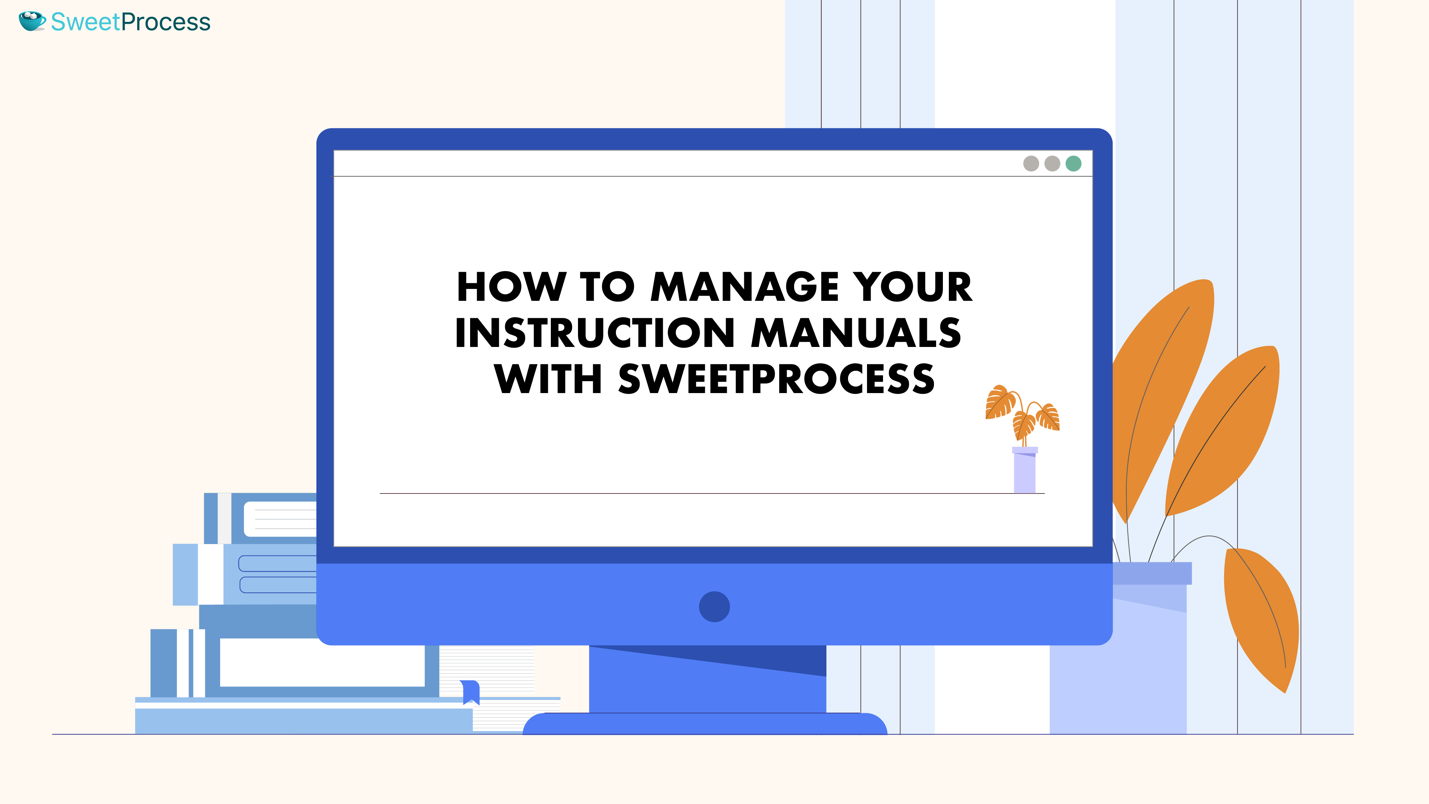
Managing instruction manuals can be time-consuming and chaotic, especially when you’re handling constant updates and working with multiple team members across different regions. However, you can eliminate these inefficiencies with the right tools like SweetProcess.
This software provides a centralized, user-friendly platform where businesses can seamlessly create, store, and manage instruction manuals. Your team can easily access policies, step-by-step processes and procedures for improved productivity.
Here’s how you can use SweetProcess to optimize your user documentation process:
Document Your Instruction Manual as Step-by-Step Guides
A well-structured instruction manual should be interactive and easy to follow. You need a guide that employees can access, follow, and update effortlessly. Instead of relying on outdated separate documents, SweetProcess allows teams to:
- Break down complex instructions into step-by-step processes that are easy to follow.
- Embed images, videos, and checklists to enhance clarity and usability.
- Update procedures in real time so employees always have the most current version.
For example, if a manufacturing company needs to update machine operation instructions, SweetProcess ensures employees always follow the latest version without confusion.
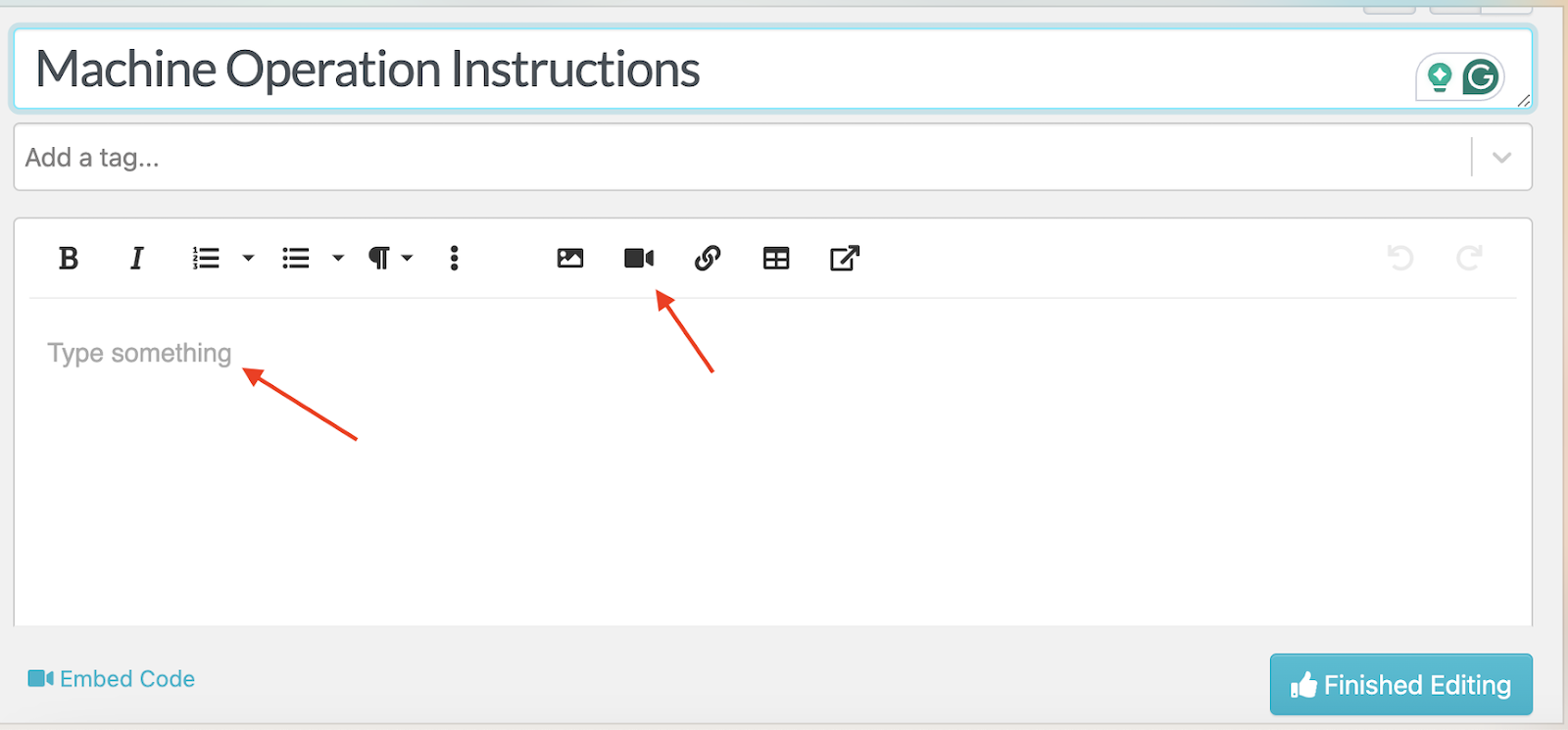
No more outdated manuals sitting in shared drives—every procedure is structured, searchable, and instantly accessible from the dashboard.

Create Company Policies on How To Use Your Instruction Manuals
An instruction manual is only effective when employees know when and how to use it. Without clear policies, employees may overlook important guides, leading to mistakes, inefficiencies, and compliance risks.
SweetProcess enables companies to:
- Define and create company-wide policies on instruction manual usage and ensure compliance.

- Set permissions and access controls so only authorized personnel can edit critical processes. Approval workflows in SweetProcess ensures that policies are reviewed before they go live.

For instance, a human resource team can use SweetProcess to standardize onboarding instructions, ensuring every new hire receives and follows the same training steps.
Turn Your Instruction Manuals Into an External Knowledge Base
Most businesses need to educate their customers, partners, or vendors on using their products and services. Instead of manually sending documents or answering the same questions repeatedly, SweetProcess is the go-to tool for converting internal instruction manuals into a public knowledge base accessible to customers.
For instance, a software company using SweetProcess can publish troubleshooting guides and turn them into a knowledge base with how-to manuals for customers.

- Once you open your knowledge bases, scroll to the “Control Access” section and check the “Public” option to make it accessible.
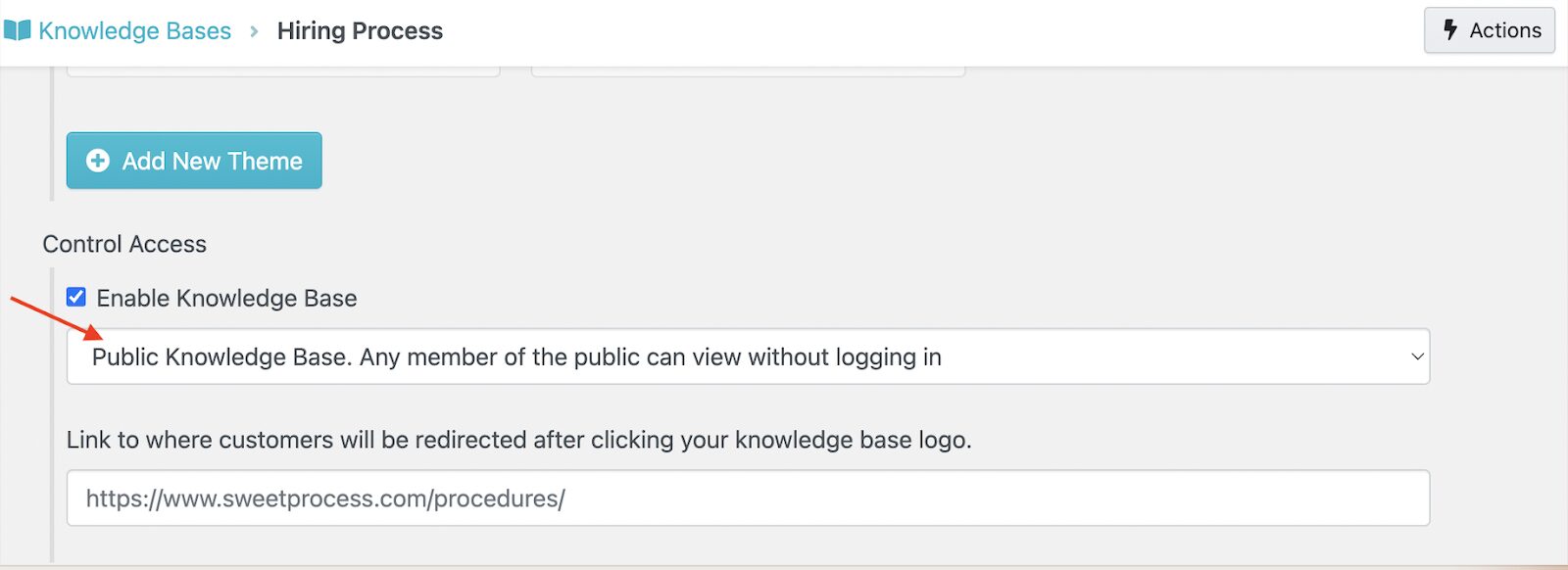
This streamlines customer support by reducing repetitive queries with self-service guides. When you embed manuals directly on websites, users can quickly find answers.
Manage Your Company’s Instruction Manuals and Policies in One Place
Without a central hub, instruction manuals often become fragmented across email threads, outdated shared folders, and disconnected documents. SweetProcess solves this by offering:
- A single source of truth for all instruction manuals, policies, and procedures.
- Real-time collaboration tools so teams can contribute and update manuals without confusion.
- Searchable documentation so employees can instantly find the instructions they need.
For example, a healthcare facility managing strict compliance procedures can store all operational guidelines in SweetProcess, ensuring every staff member follows the latest health and safety protocols. The employees can use the search button to find a specific manual and proceed to update, share, or delete it.

Let’s take a look at the companies that have used SweetProcess features to streamline their user documentation process.
One of them is Rise25. Despite being highly process-driven, the company struggled with disorganized documentation and manual SOP management using Google Docs. Employees found it difficult to locate standard operating procedures, leading to delays, inefficiencies, and constant back-and-forth requests.
Realizing that Google Docs was too unstructured and inefficient for business process documentation, Dr. Jeremy Weisz, the co-founder, sought a more organized and accessible solution. The company chose SweetProcess because of its user-friendly interface, built-in approval workflows, and searchability. This allows team members to easily create, find, and update SOPs without relying on manual input.
Here are the measurable improvements they’ve achieved with SweetProcess:
- Effective documentation: The step-by-step SOPs improved clarity and execution.
- Easier searchability: Team members can instantly locate SOPs without confusion.
- Seamless procedure referencing: Employees can link related processes within SOPs for better workflow integration.
- Automated approvals: SweetProcess streamlined document reviews and approvals, reducing delays.
- Simplified onboarding: New employees and clients followed standardized onboarding procedures, saving time.
Another beneficiary of SweetProcess is Spark Marketer, a digital marketing agency that specializes in helping small and medium-sized local businesses grow through customized online marketing strategies. For years, the company operated without standardized documentation, relying on tribal knowledge to complete tasks.
Employees lacked clear guidelines, leading to inconsistencies, inefficiencies, and difficulties tracking performance. The absence of SOPs meant that when employees made mistakes, there was no clear benchmark for improvement, making terminations feel subjective rather than performance-based.
As the company grew, the leadership team realized that Google Docs was not a scalable solution for SOPs. After discovering SweetProcess through a podcast, co-founder Carter Harkins signed up for a free trial and was immediately impressed by:
- Simplified process documentation: Breaking down SOPs into clear, structured steps became effortless.
- Centralized knowledge base: Employees could quickly find the information they needed instead of searching through cluttered Google Docs.
- Seamless employee training: New hires and existing employees could self-train using SweetProcess instead of repeatedly asking colleagues for help.
- Increased employee accountability: Team members were required to check SweetProcess first before asking for help, reinforcing self-sufficiency.
8 Things To Include When Creating Instruction Manuals

As you create your company’s instruction manuals, they need to be clear, easy to use, and comprehensive. Here are the essential components to include to make your manual useful:
Product Identification Info
Imagine buying a new electronic device but realizing the manual inside doesn’t match your product. Confusing, right? This is why every instruction manual should begin with product identification details to ensure users have the correct documentation. Some of the details to include are:
- Product name and model number
- Version details (for software)
- Manufacturer information and contact details
- Date of release or last update
For example, a smartphone user manual should clearly state the device model and software version to prevent users from following incorrect instructions. A well-documented manual avoids unnecessary support inquiries and ensures users feel confident from the start.
Product Specifications and Description
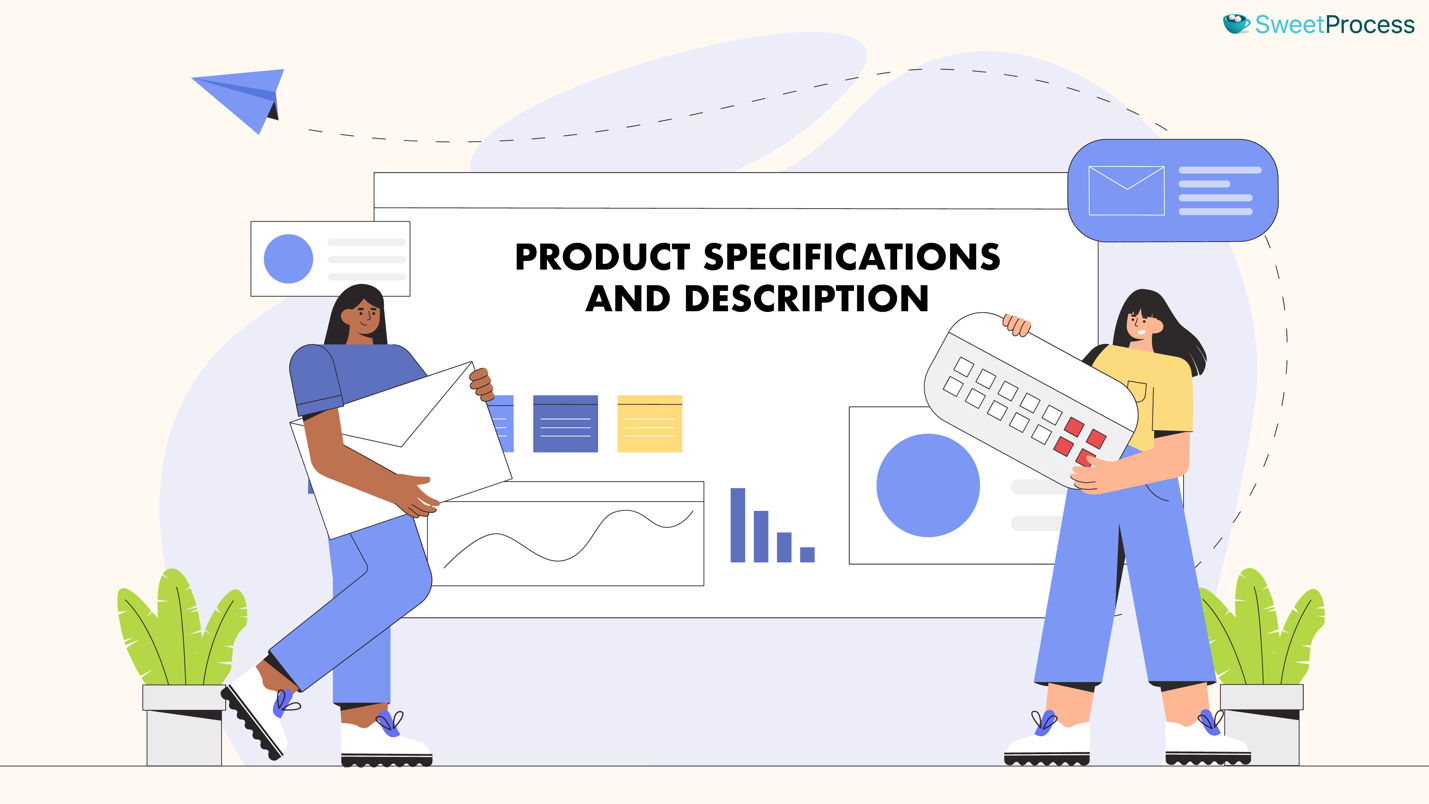
Before diving into usage instructions, users need to understand what the product is, what it does, and its key technical details. A clear product description eliminates guesswork and helps users determine whether they are using the right tool for the job.
For instance, for a hardware product, this section should include dimensions, weight, materials, and connectivity options. With the right information, your customer can set it up correctly.
Usage Instructions
Let’s say you just bought a new coffee machine. Would you prefer a manual with step-by-step brewing instructions or one that assumes you just figure it out? Usage instructions are the heart of any manual. They should be detailed, structured, and easy to follow.
To make these instructions clearer:
- Use step-by-step guides with numbered actions.
- Add visuals such as diagrams, screenshots, and images for clarity.
- Include examples and real-world applications when relevant.
- Provide alternative instructions for different use cases.
Glossary of Terms

Have you ever read a report or document and felt lost because of technical jargon? That’s what happens when you have too many abbreviations without explanations in your instruction manual. A glossary ensures that all users, from beginners to experts, understand the language used in the manual. Here are some best practices:
- Define industry-specific terms in simple language.
- Provide abbreviations and acronyms with explanations.
- Use examples to clarify complex concepts.
For instance, in a cybersecurity software manual, users might not immediately understand terms like “encryption key,” “multi-factor authentication,” or “phishing detection.” A glossary bridges that knowledge gap, making the instructions more accessible and actionable.
Troubleshooting Info and FAQ

What happens when something goes wrong? A troubleshooting section helps users resolve issues independently instead of relying on customer support. Some of the common issues to address in this section include:
- The product is not turning on or responding.
- Error messages and what they mean.
- Connectivity or installation problems.
- Performance issues and quick fixes.
This section should follow a “problem-solution” format for easy reference.
For example:
Problem: The device is not charging.
Solution: Ensure the power adapter is properly plugged in. Try using a different outlet. If the issue persists, contact support.
Including an FAQ section is also a great way to preemptively answer user questions, reducing frustration and the number of support requests.
Safety Precautions
Neglecting safety instructions can lead to user harm, product damage, or even legal issues. A safety section is a non-negotiable requirement if your product involves electrical components, sharp objects, or chemical substances. To boost these precautions, you should:
- List hazards and precautions such as fire risk, high voltage, and choking hazard.
- Specify who should/shouldn’t use the product (e.g., “Not suitable for children under 3 years old”).
- Provide emergency instructions if something goes wrong.
Policies and Terms of Use
The policies and terms of use section outlines user responsibilities, warranty coverage, and company disclaimers. You could add these details:
- Warranty information: Length of warranty, coverage details, and conditions for voiding it.
- User responsibilities: What the customer must do to maintain compliance.
- Liability disclaimer: Limitations of responsibility in case of misuse.
- Customer support information: How and when to reach out for help.
For example, a fitness equipment company may include a disclaimer stating that they are not responsible for injuries resulting from improper use. This statement provides legal protection for the business while cautioning users to be careful.
For businesses that require customers to submit key details before service delivery, using a client intake form template ensures that all necessary information is collected while maintaining compliance.
Table of Contents and Index
Some instruction manuals are quite long with several sections. A table of contents is vital because it allows users to quickly find what they need without scrolling too much. To organize your manual, group your sections logically for easy navigation.
You can also include clickable links for digital manuals so that users can instantly jump to the right section. Also, add a separate index listing key terms and topics alphabetically.
6 Benefits of Creating Instruction Manuals For Your Business
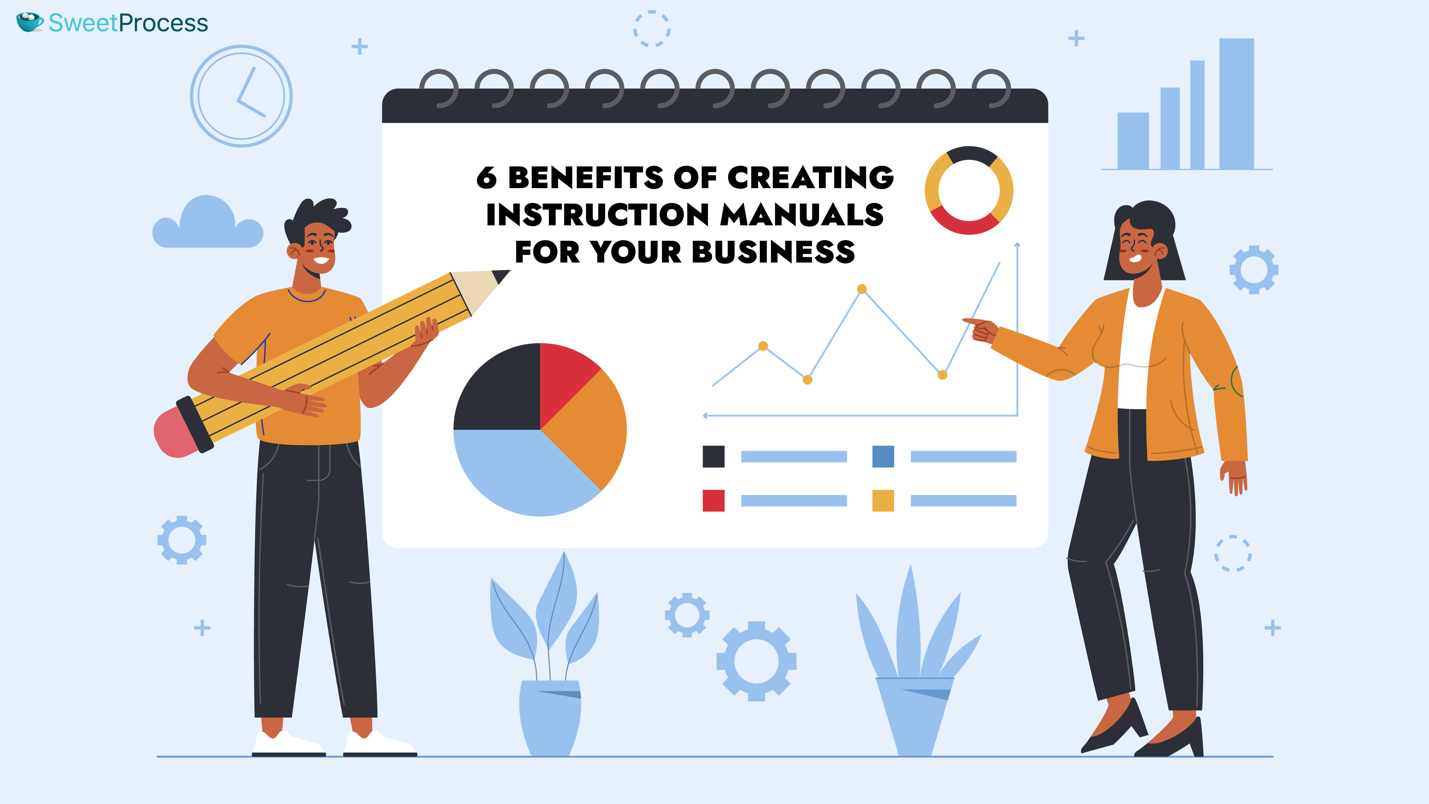
Here are the major benefits of well-structured instruction manuals and why they are essential to your business operations.
Promote Correct and Optimal Product Use
You don’t want your customers to use your products incorrectly. No matter how advanced or high-quality a product is, users won’t get the full benefits if they don’t know how to set it up, operate it, or maintain it properly.
For instance, your fitness brand has launched a new smart treadmill with multiple workout modes. If the manual only covers basic setup but fails to explain how to access the customized training programs, heart-rate tracking, or incline settings, users may not fully utilize the product and might even be injured.
A well-written instruction manual:
- Guides users step-by-step on how to use the product efficiently.
- Highlights best practices to maximize product lifespan.
- Ensures customers fully utilize advanced features rather than ignoring them.
Prevent Incorrect Use of Product

What happens when products are used incorrectly?
- Customers can be frustrated.
- The products will get damaged.
- There could be safety issues.
- There might be unnecessary returns due to bad customer experiences.
All these issues could easily be avoided with a clear instruction manual. As you onboard your client, provide clear instructions and warnings about potential misuse. You should also include the do’s and don’ts to minimize safety risks.
Offer Self-Service Resources
Studies show that customers prefer self-service resources over speaking to a support agent. Instruction manuals allow users to solve issues independently instead of relying on your customer support teams for every minor problem.
For instance, if you have a manual with troubleshooting guides and FAQs, customers don’t have to overwhelm you with repetitive inquiries. They can refer to the knowledge base and get solutions.
With detailed self-service resources, your organization can:
- Free up customer support teams to handle more complex issues.
- Improve the customer experience by giving users instant solutions.
- Reduce operational costs by minimizing time spent on avoidable support calls.
Improve User Adoption and Retention Rates

Have you ever signed up for a new software but abandoned it because the setup was too complicated? A lack of clear guidance often leads users to give up before experiencing the product’s value, negatively impacting user adoption and retention.
For instance, if a customer just subscribed to your business tools but struggles with integration and customization options, they might move on to a competitor with clearer onboarding resources. However, if your instruction manual is comprehensive and helpful, they can follow through until they become comfortable with the product, which improves retention rates.
Save Time and Resources Internally
Organizations can benefit significantly from implementing an SOP Manual to save time and resources internally. When IT departments are bogged down by repetitive employee requests, such as resetting login credentials or connecting to company tools, it detracts from their ability to focus on high-value tasks.
A centralized SOP Manual containing step-by-step instructions for routine processes empowers employees to resolve common issues independently. This reduces the workload on IT teams and enhances overall productivity, allowing them to prioritize growth-oriented activities.
An Asset for Marketing and Sales Teams

Clear documentation can be a major selling point. Customers are more likely to purchase a product if they know it comes with well-documented guidance, reducing purchase anxiety. As your marketing and sales teams promote your products and services, they can highlight how easy it is to set up and customize them.
This way, customers feel confident buying the product, knowing they won’t struggle with installation. Your teams can also build trust by showcasing your customer-friendly support resources. This helps close deals faster, especially for technical products that require onboarding.
Streamline Your Instruction Manuals With SweetProcess

Your instruction manuals should work like invisible assistants, guiding employees and customers through processes without constant supervision. Yet, too often, manuals are outdated, poorly documented, or so complex that no one uses them.
If your organization continues to rely on messy, disconnected documentation, you’ll end up wasting time, frustrating your teams, and creating inefficiencies that hurt their bottom line. Imagine if every task, from employee onboarding to product troubleshooting, was mapped out in a structured, easy-to-access system.
That’s exactly what SweetProcess delivers. With its intuitive platform, real-time updates, and powerful search features, your instruction manuals become readily available resources that employees actually use and customers appreciate.
If managing and updating your instruction manuals feels like a constant challenge, SweetProcess can change that. To get started, sign up for a 14-day free trial of SweetProcess today.
